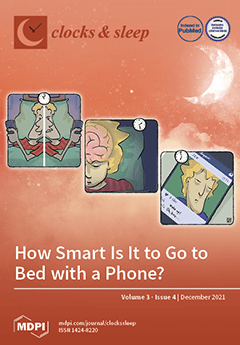The primary aims of the present study were to examine the impact of chronotype on sleep/wake behaviour, perceived exertion, and training load among professional footballers. Thirty-six elite female professional football player’s (mean ± SD: age, 25 ± 4 y; weight, 68 ± 7
[...] Read more.
The primary aims of the present study were to examine the impact of chronotype on sleep/wake behaviour, perceived exertion, and training load among professional footballers. Thirty-six elite female professional football player’s (mean ± SD: age, 25 ± 4 y; weight, 68 ± 7 kg) sleep and training behaviours were examined for 10 consecutive nights during a pre-season period using a self-report online player-management system and wrist activity monitors. All athletes completed the Morningness-Eveningness Questionnaire (rMEQ) on the first day of data collection. Eleven participants were morning types, seventeen participants were intermediate types, and three participants were evening types. Separate linear mixed models were conducted to assess differences in sleep, perceived exertion, and training behaviours between chronotype groups. Morning types woke up earlier (wake time: 07:19 ± 01:16 vs. 07:53 ± 01:01,
p = 0.04) and reported higher ratings of perceived exertion compared to intermediate types (6.7 ± 1.1 vs. 5.9 ± 1.2,
p = 0.01). No differences were observed between chronotype groups for bedtime, time in bed, total sleep time, sleep efficiency, training duration, or training load. In circumstances where professional female football players are required to train at a time opposing their natural circadian preference (e.g., morning type training in the evening), their perceived exertion during training may be higher than that of players that are training at a time that aligns with their natural circadian preference (e.g., evening type training in the evening). It is important for practitioners to monitor individual trends in training variables (e.g., rating of perceived exertion, training load) with relation to athlete chronotype and training time. Future research should examine the relationship between chronotype, training time, and rating of perceived exertion across different training durations.
Full article






